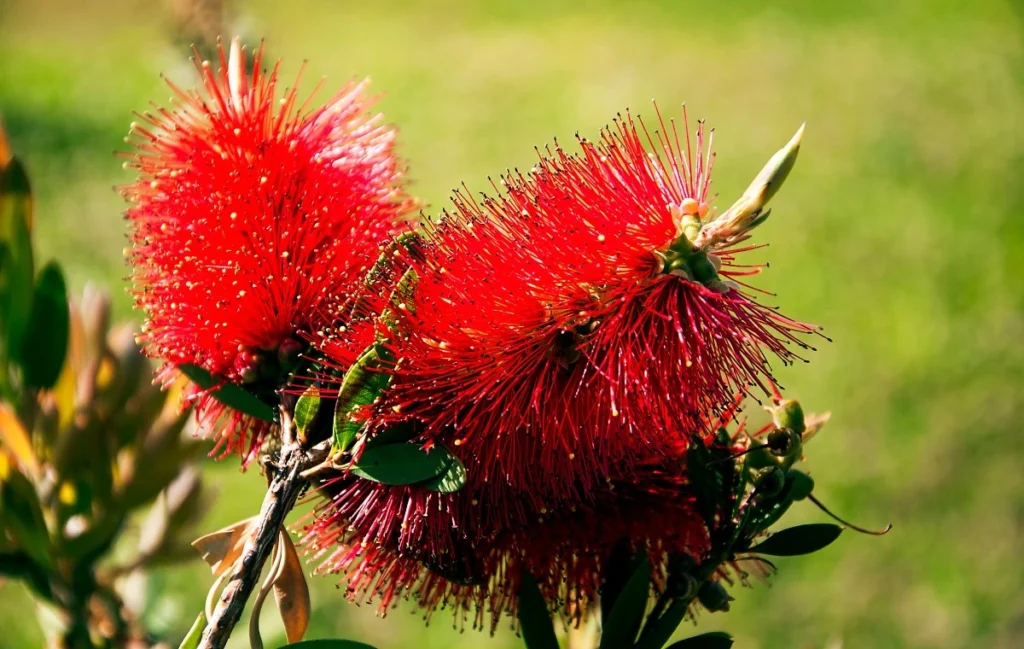Bottlebrush tree is the popular name for plants of the genus Callistemon. This genus comprises 34 cataloged species, most of which are native to Australia. The name Callistemon originates from ancient Greek, where “kallos” means “beautiful” and “stemon” means “stamen.” This denomination directly references the showy, colorful stamens that characterize the inflorescences of these plants, resembling bottlebrushes.
Bottlebrushes exhibit a shrub or small tree form, reaching 3 to 7 meters (10 to 23 feet) in height. Their leaves are generally small, lanceolate to linear, green, sessile, perennial, and aromatic, gradually turning bronze over time.

However, the charm of this tree lies in its inflorescences. They have a cylindrical shape with numerous stamens, similar to the brushes used for cleaning bottles and baby bottles. Highly attractive to hummingbirds, the flowers appear sparsely throughout the year and abundantly in spring. In summer, they are replaced by small, woody fruits that cling tightly to the branches.
Interestingly, the bottlebrush has a rather peculiar seed dispersal mechanism. The woody fruits retain the seeds for long periods, releasing them only when environmental conditions are favorable, such as after a fire. This mechanism is an adaptation to the environmental conditions of Australia, where wildfires are common and part of the natural landscape renewal cycle.

In landscaping, the bottlebrush stands out as a solitary tree, especially at the edge of lakes, where its drooping branches can gracefully touch the water. It is also suitable for forming hedges, not compact but very showy if pruned regularly. Other compositions can be made, given the versatility of this plant with its exotic appearance and singular beauty.
Its hardiness and low maintenance, combined with its moderate growth, make the bottlebrush a preferred tree in many landscaping projects. The most popular species in landscaping are C. viminalis and C. citrinus, but there are many varieties and hybrids with red flowers and some with pink and white flowers as well.

Bottlebrushes can also be grown in pots, provided a large, well-drained container is used. This allows the plant to develop a healthy root system and support its canopy and lush flowers. Due to its moderate growth and ability to adapt to pruning, they are an interesting choice for bonsai enthusiasts. Regular pruning of the roots and branches, along with proper training, can result in beautiful bonsai specimens with impressive inflorescences.
In addition to its ornamental use, some Callistemon species also have medicinal properties. In traditional Aboriginal medicine, the plant is used to treat many ailments, primarily infections caused by viruses, bacteria, fungi, and parasitic infestations.

They should be cultivated in full sun and are not demanding regarding soil fertility. Generally, they adapt very well to waterlogged or dry soils. Watering should be regular, especially during hotter periods, but constant waterlogging of the substrate should be avoided. They thrive in subtropical or Mediterranean cold and tolerate frost and tropical climates.
Another advantage of bottlebrushes is their resistance to pests and diseases. These plants are generally healthy and require little intervention to remain vigorous. Radical pruning is not tolerated. Annual fertilization stimulates intense flowering. They are propagated by seeds and semi-hardwood cuttings. The small fruits should be harvested and stored in paper bags in a warm, dry greenhouse until the seeds are released.


